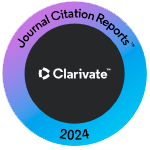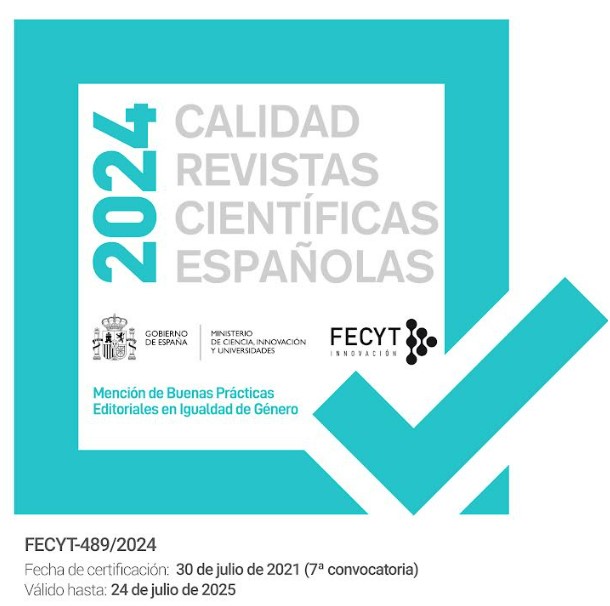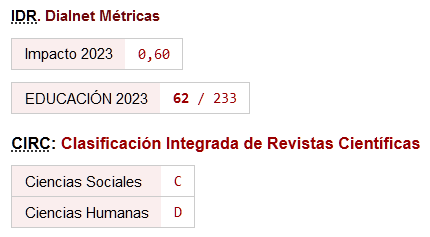Estrés percibido debido a la pandemia de COVID-19 entre los profesores profesionales empleados
DOI:
https://doi.org/10.46661/ijeri.5284Palabras clave:
COVID-19, salud mental, pandemia, estrés, profesoresResumen
La aparición inesperada del brote de COVID-19 ha interrumpido sin lugar a dudas la normalidad de la vida. El estrés se ha convertido en una preocupación importante en la educación desde el brote de COVID-19. Esta encuesta en línea descriptiva-correlacional administrada en agosto de 2020 utilizó la Escala de estrés percibido COVID-19 (COVID-19 PSS-10) para evaluar el estrés percibido por COVID-19 entre los profesores filipinos empleados. Whitney U y Kruskal-Wallis probaron las diferencias mientras que la rho de Spearman se utilizó para analizar la correlación entre las variables. Los resultados demostraron que más de la mitad de los maestros experimentaron un estrés moderado por COVID-19. Las mujeres experimentaron un estrés por COVID-19 significativamente mayor en comparación con los hombres. Se observó una correlación negativa entre la salud autoevaluada y el estrés por COVID-19, mientras que se encontró una correlación positiva entre el riesgo percibido de contraer la infección por COVID-19 y el estrés por COVID-19. Este estudio destaca que se deben tomar medidas para ayudar a los maestros a lidiar con el estrés de la crisis de COVID-19, así como se les debe proporcionar o enseñar intervenciones de manejo del estrés durante esta pandemia. Este estudio podría usarse como base para futuras investigaciones para evaluar el impacto del estrés por COVID-19 entre los profesores profesionales.
Descargas
Citas
Abdulah, D. M., y Mohammed, A. A. (2020). The consequences of the COVID-19 pandemic on perceived stress in clinical practice: Experience of doctors in Iraqi Kurdistan. Romanian Journal of Internal Medicine, 1. https://doi.org/10.2478/rjim-2020-0020
Agai–Demjaha, T., Bislimovska, J. K., y Mijakoski, D. (2015). Level of work related stress among teachers in elementary schools. Macedonian Journal of Medical Sciences, 3(3), 484-488. http://dx.doi.org/10.3889/oamjms.2015.076
AlAteeq, D. A., Aljhani, S., y AlEesa, D. (2020). Perceived stress among students in virtual classrooms during the COVID-19 outbreak in KSA. Journal of Taibah University Medical Sciences, 15(5), 398-403. https://doi.org/10.1016/j.jtumed.2020.07.004
Alson, J. (2019). Stress among public school teachers. Journal of Research Initiatives, 4(2), 1-5. Retrieved from: https://digitalcommons.uncfsu.edu/jri/vol4/iss2/3
Alves, R., Lopes, T., y Precioso, J. (2020). Teachers' well-being in times of Covid-19 pandemic: Factors that explain professional well-being. International Journal of Educational Research and Innovation, 15, 203-217. Retrieved from: https://doi.org/10.46661/ijeri.5120
Campo-Arias, A., Perdomo-Rojas, J. A., y Caballero-Domínguez, C. C. (2020). Social capital and perceived stress related to coronavirus disease in Colombia. Journal of Epidemiology & Community Health, 74(10), 872. http://dx.doi.org/10.1136/jech-2020-215005
Centers for Disease Control and Prevention. (2020a). Coronavirus disease 2019 (COVID-19). Retrieved from: https://www.cdc.gov/coronavirus/2019-ncov/need-extra-precautions/older-adults.html
Centers for Disease Control and Prevention (2020b). Coronavirus disease 2019 (COVID-19). Retrieved from: https://www.cdc.gov/coronavirus/2019-ncov/need-extra-precautions/people-with-medical-conditions.html
Center for Strategic and International Studies. (2020b). Southeast Asia covid-19 tracker. Retrieved from: https://www.csis.org/programs/southeast-asia-program/southeast-asia-covid-19-tracker-0
Di Fronso, S., Costa, S., Montesano, C., Di Gruttola, F., Ciofi, E. G., Morgilli, L., Robazza, C., y Bertollo, M. (2020). The effects of COVID-19 pandemic on perceived stress and psychobiosocial states in Italian athletes. International Journal of Sport and Exercise Psychology, 1-13. https://doi.org/10.1080/1612197X.2020.1802612
Ganzach, Y., Ellis, S., Pazy, A., y Ricci-Siag, T. (2008). On the perception and operationalization of risk perception. Judgment and Decision Making, 3(4), 317-324. Retrieved from: https://psycnet.apa.org/record/2008-05834-003
Garcia, L. L., Castillo, J. M., Bejoc, J., Redula, E. H., Lapa, M. M. I., y Palompon, D. (2020). Understanding COVID-19 dispersion in the Filipino sociocultural context. Asia Pacific Journal of Health Management, 15(3), 13-17. https://doi.org/10.24083/apjhm.v15i3.467
Guillasper, J. N., Soriano, G. P., y Oducado, R. M. F. (2020). Psychometric properties of ‘attitude towards e-learning scale’ among nursing students. International Journal of Educational Sciences, 30, (1-3), 1-5. https://doi.org/10.31901/24566322.2020/30.1-3.1135
Haddock, C. K., Poston, W. S., Pyle, S. A., Klesges, R. C., Vander Weg, M. W., Peterson, A., y Debon, M. (2006). The validity of self-rated health as a measure of health status among young military personnel: Evidence from a cross-sectional survey. Health and Quality of Life Outcomes, 4(1), 57. https://doi.org/10.1186/1477-7525-4-57
Kabito, G. G., y Wami, S. D. (2020). Perceived work-related stress and its associated factors among public secondary school teachers in Gondar city: A cross-sectional study from Ethiopia. BMC Research Notes, 13(1), 1-7. https://doi.org/10.1186/s13104-020-4901-0
Lam, S. C., Arora, T., Grey, I., Suen, L. K. P., Huang, E. Y. Z., Li, D., y Lam, K. B. H. (2020). Perceived risk and protection from infection and depressive symptoms among healthcare workers in mainland China and Hong Kong during COVID-19. Frontiers in Psychiatry, 11, 686. https://doi.org/10.3389/fpsyt.2020.00686
Limcaoco, R. S. G., Mateos, E. M., Fernandez, J. M., y Roncero, C. (2020). Anxiety, worry and perceived stress in the world due to the COVID-19 pandemic, March 2020. Preliminary results. medRxiv. https://doi.org/10.1101/2020.04.03.20043992
Liu, S., Lithopoulos, A., Zhang, C. Q., Garcia-Barrera, M. A., y Rhodes, R. E. (2020). Personality and perceived stress during COVID-19 pandemic: Testing the mediating role of perceived threat and efficacy. Personality and Individual Differences, 168, 110351. https://doi.org/10.1016/j.paid.2020.110351
Lorem, G., Cook, S., Leon, D. A., Emaus, N., y Schirmer, H. (2020). Self-reported health as a predictor of mortality: A cohort study of its relation to other health measurements and observation time. Scientific Reports, 10(1), 1-9. https://doi.org/10.1038/s41598-020-61603-0
Mariotti, A. (2015). The effects of chronic stress on health: New insights into the molecular mechanisms of brain–body communication. Future Science, 1(3). https://doi.org/10.4155/fso.15.21
Mirón, J., Goldberg, X., López-Sola, C., Nadal, R., y Armario, A. (2019). Perceived stress, anxiety and depression among undergraduate students: An online survey study. Journal of Depression & Anxiety, 8(1), 1-5. https://doi.org/10.4172/2167-1044.1000330
Mondol, M.S., y Mohiuddin, M.G. (2020). Confronting COVID-19 with a paradigm shift in teaching and learning: A study on online classes. International Journal of Social, Political and Economic Research, 7(2), 231-247. https://doi.org/10.46291/IJOSPERvol7iss2pp231-247
Moralista, R. B., y Oducado, R. M. F. (2020). Faculty perception toward online education in a state college in the Philippines during the coronavirus disease 19 (COVID-19) pandemic. Universal Journal of Educational Research, 8(10), 4736-4742. https://doi.org/10.13189/ujer.2020.081044
Nanjundaswamy, M. H., Pathak, H., y Chaturvedi, S. K. (2020). Perceived stress and anxiety during COVID-19 among psychiatry trainees. Asian Journal of Psychiatry, 54, 102282. https://doi.org/10.1016/j.ajp.2020.102282
Nulty, D.D. (2008). The adequacy of response rates to online and paper surveys: What can be done?. Assessment & Evaluation in Higher Education, 33(3), 301-314. https://doi.org/10.1080/02602930701293231
Pagayanan, R. (2016). Stress profile of public elementary school teachers in Tacloban city division: Inputs for a proposed classroom intervention program. In International Conference on Research in Social Sciences, Humanities and Education, May 20-21, 2016 Cebu (Philippines), 126-129. Retrieved from: http://uruae.org/siteadmin/upload/UH0516121.pdf
Pedrozo-Pupo, J. C., Pedrozo-Cortés, M. J., y Campo-Arias, A. (2020). Perceived stress associated with COVID-19 epidemic in Colombia: An online survey. Cadernos de Saúde Pública, 36, e00090520. https://doi.org/10.1590/0102-311x00090520
Philippine Department of Health. (2020). COVID-19 case bulletin #182. Retrieved from: https://www.doh.gov.ph/covid-19/case-tracker
Priya, K. B., Rajendran, P., Kumar, S., Prabhu, J., Rajendran, S., Kumar, P. J., Thanapal P., Jabez, C., y Jothikumar, R. (2020). Pediatric and geriatric immunity network mobile computational model for COVID-19. International Journal of Pervasive Computing and Communications, 16(4), 321-330. https://doi.org/10.1108/IJPCC-06-2020-0054
Qiu, J., Shen, B., Zhao, M., Wang, Z., Xie, B., y Xu, Y. (2020). A nationwide survey of psychological distress among Chinese people in the COVID-19 epidemic: Implications and policy recommendations. General Psychiatry, 33(2), e100213. http://dx.doi.org/10.1136/gpsych-2020-100213
Reimer, F. M., y Schleicher, A. (2020). Schooling disrupted, schooling rethought: How the COVID-19 pandemic is changing education. Retrieved from: https://globaled.gse.harvard.edu/files/geii/files/education_continuity_v3.pdf
Tan, J. S. T. (2017). Factors affecting stress among faculty members of public universities in the Philippines: A multiple regression analysis. International Journal of Psychological Studies, 9(3), 64-78. http://doi.org/10.5539/ijps.v9n3p64
Teh, H. C., Archer, J. A., Chang, W., y Chen, S. A. (2015). Mental well‐being mediates the relationship between perceived stress and perceived health. Stress and Health, 31(1), 71-77. https://doi.org/10.1002/smi.2510
Wu, S., Wang, R., Zhao, Y., Ma, X., Wu, M., Yan, X., y He, J. (2013). The relationship between self-rated health and objective health status: A population-based study. BMC Public Health, 13(1), 320. https://doi.org/10.1186/1471-2458-13-320
Yıldırım, M., y Güler, A. (2021). Positivity explains how COVID-19 perceived risk increases death distress and reduces happiness. Personality and Individual Differences, 168, 110347. https://doi.org/10.1016/j.paid.2020.110347
Younas, S., Tahir, F., Sabih, F., Hussain, R., Hassan, A., Sohail, M., Hafa, S. Z. N., Munawar, A., Kanwal, R., Tanvir, M. y Zahra, M. (2020). Psychological capital and mental health: Empirical exploration in perspective of gender. Ponte Academic Journal, 76(1), 150-175. https://doi.org/10.21506/j.ponte.2020.1.11
Yulitasari, B. I., Amatayakul, A., y Karuncharerernpanit, S. (2015). The relationship between perceived health status, activity of daily living, coping strategies, religiosity, and stress in the elderly at a public nursing home in Yogyakarta, Indonesia. Journal of Health Research, 29(Suppl. 1), S97-S101. Retrieved from: https://he01.tci-thaijo.org/index.php/jhealthres/article/view/79900
Zandifar, A., y Badrfam, R. (2020). Iranian mental health during the COVID-19 epidemic. Asian Journal of Psychiatry, 51, 101990. https://doi.org/10.1016/j.ajp.2020.101990
Zhang, J., Wu, W., Zhao, X., y Zhang, W. (2020). Recommended psychological crisis intervention response to the 2019 novel coronavirus pneumonia outbreak in China: A model of West China Hospital. Precision Clinical Medicine, 3(1), 3-8. https://doi.org/10.1093/pcmedi/pbaa006
World Health Organization. (2020a). Mental health and psychosocial considerations during the COVID-19 outbreak (No. WHO/2019-nCoV/MentalHealth/2020.1). Retrieved from: https://apps.who.int/iris/handle/10665/331490
World Health Organization. (2020b). WHO coronavirus disease (COVID-19) dashboard. Retrieved from:
Descargas
Publicado
Cómo citar
Número
Sección
Licencia
Derechos de autor 2020 Ryan Michael Oducado, Judith Rabacal, Rome Moralista, Khen Tamdang

Esta obra está bajo una licencia internacional Creative Commons Atribución-NoComercial-SinDerivadas 4.0.












